Stuyvesant High School
| Stuyvesant High School | |
 |
|
| Location | |
|---|---|
| 345 Chambers Street New York City, New York, United States |
|
| Information | |
| Type | Public (Exam school) secondary |
| Motto | Pro Scientia Atque Sapientia (Latin: For knowledge and wisdom) |
| Established | 1904 |
| School board | New York City Public Schools |
| School number | M475 |
| CEEB Code | 334070 |
| Principal | Stanley Teitel |
| Faculty | 152[1] |
| Grades | 9–12 |
| Number of students | 3300[2] |
| Color(s) | Red and blue |
| Mascot | Peter Stuyvesant |
| Nickname | Stuy[3] |
| Average SAT scores | 2090[4] |
| Newspaper | The Spectator |
| Yearbook | The Indicator |
| Website | www.stuy.edu |
Stuyvesant High School (pronounced /ˈstaɪvɨsənt/), commonly referred to as Stuy (/stаɪ/),[3] is a New York City public high school that specializes in mathematics and science. The school opened in 1904 on Manhattan's East Side and moved to a new building in Battery Park City in 1992. Stuyvesant is noted for its strong academic programs, having produced many notable alumni including four Nobel laureates.[5] U.S. News & World Report ranked it thirty-first in their 2009 list of America's best "Gold-Medal" public high schools.[6]
Together with Brooklyn Technical High School and Bronx High School of Science, Stuyvesant is one of the three original academic Specialized High Schools of New York City. Run by the New York City Department of Education, the trio are open to New York City residents and charge no tuition. Admission to each is by competitive examination only, of which Stuyvesant has the highest cutoff score. A long-standing friendly rivalry between Stuyvesant and Bronx Science exists over the Intel Science Talent Search, with each school claiming dominance over the other at various times.
Established as an academic and vocational school for boys in 1904, Stuyvesant became coeducational in 1969. Upon the construction of its Battery Park City building, the facilities for girls became equal with those for boys.
Contents |
History
Stuyvesant High School is named after Peter Stuyvesant, the last Dutch governor of New Netherland before the colony was transferred to England in 1664.[7]
The school was established in 1904 as a manual training school for boys, hosting 155 students and 12 teachers. In 1907, it moved from its original location at 225 East 23rd Street to a building designed by C. B. J. Snyder at 345 East 15th Street, where it remained for 85 years. Its reputation for excellence in math and science continued to grow, and enrollment was restricted based on scholastic achievement starting in 1919.[8]
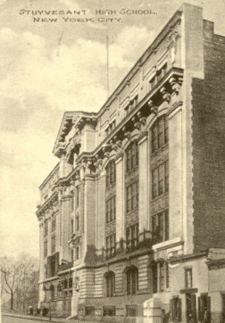
The school went on a double session plan in 1919 to accommodate the rising number of students. Some students attended in the morning and others in the afternoon and early evening. All students studied a full set of courses. Double sessions ran until 1956.[8][9]
In 1934, the school implemented a system of entrance examinations. The examination program was later expanded to include the newly founded Bronx High School of Science, and was developed with the assistance of Columbia University.[10] During the 1950s, the building underwent a $2 million renovation to update its classrooms, shops, libraries and cafeterias.[10]
In 1956, a team of six students designed and began construction of a cyclotron. The team was headed by Martin Gersten and included John Sutherland, Charles Abzug and Robert Rudko. The faculty advisor was Mr. Abraham Kerner of the Chemistry Department. By 1962, a low-power test of the device succeeded. Matt Deming (1962) remembered that a later attempt at full-power operation "tanked the electrical system for the building and surrounding area".[11][12]
In 1969, 14 girls were admitted to Stuyvesant and 12 enrolled at the start of September, marking the school's first co-educational year. Now, approximately 43% of students are female.[13]
In 1972, Brooklyn Tech, Bronx Science, Stuyvesant, and The High School of Music & Art (now Fiorello H. LaGuardia High School of Music & Art and Performing Arts) were chosen by the New York State Legislature as specialized high schools of New York City. The Hecht-Calandra act called for a uniform exam to be administered for admission to Brooklyn Tech, Bronx Science and Stuyvesant High School.[14] The exam, named the Specialized High Schools Admissions Test (SHSAT), tested students in math and verbal abilities. Admission to LaGuardia High School is by audition rather than examination, in keeping with its artistic mission.[14]
In 1992, a new waterfront building was constructed to house the high school (see school facilities). The original building remains in use, as "Old Stuyvesant Campus", housing the Institute for Collaborative Education, the High School for Health Professions and Human Services and P.S. 226.
During the 2003–2004 school year, Stuyvesant celebrated the 100th anniversary of its founding with a full year of activities. Events included a procession from the 15th Street building to the Chambers Street one; a meeting of the National Consortium for Specialized Secondary Schools of Mathematics, Science and Technology; an all-class reunion; and visits and speeches from notable alumni. In recent years, keynote graduation speakers have included Attorney General Eric Holder (2001), former President Bill Clinton (2002), GE CEO Jack Welch (2003), United Nations Secretary General Kofi Annan (2004), CUNY Chancellor Matthew Goldstein (2005), Late Night comedian Conan O'Brien (2006), American Symphony Orchestra conductor/Bard College president Leon Botstein (2007), New York Times reporter David Herszenhorn (2008), actress/alumna Lucy Liu (2009), and Senior Advisor to President Barack Obama David Axelrod (2010).
Enrollment
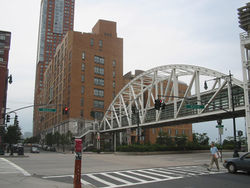
Stuyvesant has a total enrollment of over 3,000 students,[2] and is open to residents of New York City entering either ninth or tenth grade. Enrollment is based solely on performance on the Specialized High Schools Admissions Test (SHSAT).[15] The list of schools using the SHSAT has since grown to include all of New York's specialized high schools except LaGuardia High School, where entry is by audition rather than examination. The test score necessary for admission to Stuyvesant has consistently been higher than that needed for admission to the other schools using the test.[16] Admission is currently based on an individual's score on the examination and his or her pre-submitted ranking of Stuyvesant among the other specialized schools. Each year, about 26,000 of New York City's eighth-graders sit for the test.[17] Ninth and rising tenth graders are also eligible to take the test for enrollment, though far fewer students are admitted this way.[18]
According to Article 12 of New York education law, "Admissions to the Bronx High School of Science, Stuyvesant High School, and Brooklyn Technical High School shall be solely and exclusively by taking a competitive, objective, and scholastic achievement examination, which shall be open to each and every child in the city of New York."[19] The current admission policy is available from the NYC Department of Education.[16] According to the Department of Education, Stuyvesant accepts students solely based on their performance on the SHSAT, although former Mayor John Lindsay and community activist group ACORN have argued that the exam may be biased against African and Hispanic Americans.[20]
Accusations of bias in admission tests
The school's skewed demographic profile and scarcity of black and Hispanic students have often been an issue for some city administrators. Mayor John Lindsay (1966–1973) argued that the test was culturally biased against Black and Hispanic students and sought to implement an affirmative action program.[14] However, protests by parents forced the plan to be scrapped and led to the passage of the Hecht-Calandra Act, which preserved admissions by examination only. A small number of students judged to be economically disadvantaged and who come within a few points of the cut-off score are given an extra chance to pass the test.[21]
In 1996 the controversial community activist group Association of Community Organizations for Reform Now published two reports, Secret Apartheid and Secret Apartheid II, calling the SHSAT "permanently suspect" and a "product of an institutional racism", and claiming that Black and Hispanic students did not have access to proper test preparation materials.[20] Along with Schools Chancellor Rudy Crew, they began an initiative for more diversity in the city's gifted and specialized schools, in particular demanding that since only a few districts send the majority of Stuyvesant's and Bronx Science's students, that the SHSAT be suspended altogether "until the Board of Education can show that the students of each middle school in the system have had access to curricula and instruction that would prepare them for this test regardless of their color or economic status." Jesse Shapiro, Stuyvesant valedictorian, and Alan Van Dyke and Micah C. Lasher, then sophomores, published several editorials in response, and change was averted.[12][22]
A number of students take preparatory courses offered by private companies such as Princeton Review and Kaplan, in order to perform better on the SHSAT, often leaving those unable to afford such classes—often ethnic minorities—at a disadvantage. To bridge this gap and boost minority admissions, the Board of Education started the Math Science Institute in 1998,[23] a free program to prepare students for the admissions test.[24] Students attend preparatory classes through the program, now known as the Specialized High School Institute, at several schools around the city from the summer after 6th grade until the 8th grade exam. Yet with these free programs, the Black and Hispanic enrollment continue to decline. [25]
Academics
Stuyvesant students undertake a college preparatory curriculum that includes four years of English, history, and laboratory-based sciences (biology, chemistry and physics are required), three years of mathematics (most students opt for four) and three years of a single foreign language, a semester each of introductory art, music, health, technical drawing and computer science, and two lab-based technology courses. Several exemptions from technology education exist for seniors.[26][27]
Stuyvesant offers students a broad selection of elective courses. Some of the more unusual offerings include robotics, physics of music, astronomy, introduction to plasma physics, New York City history, Women's Voices, and the mathematics of financial markets.[28] Most students complete the New York City Regents courses by Junior year and take calculus during their senior year. However, the school offers math courses through differential equations for the more advanced students. A year of technical drawing used to be required; students learned how to draft by hand in its first semester and how to draft using a computer (CAD) in the second. Now, students take a one-semester technical drawing class (a compacted version of the former drafting course), and a semester of introductory computer science, which introduces NetLogo and Scheme.
Students can choose from 31 Advanced Placement courses[29] to earn college credits; a few are thus able to start college as sophomores.
Computer science enthusiasts can take two additional computer programming courses after the completion of Advanced Placement computer science: systems level programming and computer graphics. There is also a one year computer networking class which can earn students Cisco Certified Network Associate (CCNA) certification.
Stuyvesant's foreign language offerings rival those of many colleges, including Mandarin Chinese, French, Spanish, German, Latin, Hebrew, Japanese, and Italian. In 2001, Korean was added as a result of student and parent requests. The school's Muslim Student Association was successful in raising funds to support courses in Arabic, which began in 2005. Both Arabic and Korean are offered as electives.[30]
Stuyvesant's Biology and Geo-science department offers courses in molecular biology (a course sequence composed of a molecular science class in the Fall and a molecular genetics class in the Spring), human physiology, medical ethics, medical and veterinary diagnosis, human disease, anthropology and sociobiology, vertebrate zoology, laboratory techniques, medical human genetics, botany, the molecular basis of cancer, nutrition science, and psychology. The Chemistry and Physics department offers organic chemistry, physical chemistry, astronomy, engineering mechanics, and electronics.[28]
Although Stuyvesant is primarily known for its strength in areas such as math and science, the school has also developed an exceptionally strong humanities curriculum. Comprehensive programs in the humanities offer students courses in British and classical literature, Shakespearean literature, science fiction, philosophy, existentialism, debate, acting, journalism, and a host of creative writing and poetry classes. The history core requires a year of ancient, European and American history, as well as a semester of economics and government. Humanities electives include American foreign policy, civil and criminal law, "prejudice and persecution", "race, ethnicity and gender issues", small business management, and Wall Street. Stuyvesant is also home to a robust music program and offers students ten music groups, ranging from a symphony orchestra and jazz ensemble to a chamber choir.
Stuyvesant has recently entered into an agreement with City College of New York, in which the college funds advanced after-school courses that are taken for college credit but taught by Stuyvesant teachers. Some of these courses include physical chemistry, linear algebra, advanced Euclidean geometry, and women's history.[31][32]
Before the 2005 revision of the SAT, Stuyvesant graduates had an average score of 1408 out of 1600 (685 verbal, 723 math).[13] As of 2008[update], the average score is 2090 out of 2400.[4] Stuyvesant also was the high school with the highest number of Advanced Placement exams taken, and also the highest number of students reaching the mastery level.[33]
Public recognition
According to a September 2002 high school ranking by Worth magazine, 3.67% of Stuyvesant students went on to attend Harvard, Princeton, and Yale Universities, ranking it as the 9th top public high school in the United States and 120th among all schools, public or private.[34] In December 2007, The Wall Street Journal studied the freshman classes at eight selective colleges (Harvard, Princeton, MIT, Williams College, Pomona College, Swarthmore College, U. Chicago, and Johns Hopkins), and reported that Stuyvesant sent 67, or 9.9% of its 674 seniors, to them.[35]
Stuyvesant, along with other similar schools, has regularly been excluded from Newsweek's annual list of the Top 100 Public High Schools. The May 8th, 2008 issue states the reason as being, "because so many of their students score well above average on the SAT and ACT."[36][37] US News & World Report, however, included Stuyvesant on its list of "Best High Schools" published in December 2009, ranking 31st.[38]
School facilities
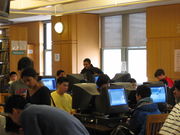
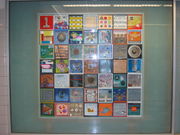
By the 1980s, the East 15th Street building was no longer a quality educational facility by modern standards. The five-story building, pictured in the black and white postcard above, was also overwhelmed by the several thousand students, leading the New York City Board of Education to secure an agreement with the Battery Park City Authority for a new building, and construction began in 1989. The new ten-floor building, located near lower Manhattan's financial district was designed by Cooper, Robertson & Partners. At a cost of about $148 million, it included 65 classrooms, about 450 computers on 13 networks, 7 pairs of escalators, various indoor sporting facilities including two gymnasiums and a pool built to Public Schools Athletic League standards, a theater with acoustics and lighting to accommodate music and drama productions, two lecture halls with movable partitions, a skylit cafeteria overlooking the Hudson River, 12 science laboratories (including a molecular biology lab and an analytical chemistry lab) and special shops for instruction in ceramics, photography, wood, plastics, metal work, robotics and energy studies. One room, called the Museum Room, was built as a replica of a room in the 15th Street Stuyvesant building as a request by students, with desks, chairs, a table and blackboard brought from there, as well as paint and flooring in its style. The room was dedicated to teacher Dr. A. Edward Stefanacci, who died in 1993. The school's library has a capacity of 40,000 volumes and overlooks Battery Park City.[39]
The New York City Department of Education reports that public per student spending at Stuyvesant is slightly lower than the city average.[13] Stuyvesant also receives private contributions.[40] Shortly after the new building was completed, the $10 million TriBeCa Bridge was built to allow students to enter the building without having to cross the busy West Street.
The new school building was designed to be fully compliant with the Americans with Disabilities Act, and is listed as such by the New York City Department of Education. As a result, the building is one of the 5 additional sites of P721M, a school for older (aged 15–21) students with multiple disabilities and mental retardation.[41]
In 1997, the eastern end of the mathematics floor was dedicated to Dr. Richard Rothenberg, the math department chairman who had died from a sudden heart attack earlier that year. Sculptor Madeleine Segall-Marx was commissioned to create the Rothenberg Memorial in his honor. She created a mathematics wall entitled "Celebration," consisting of 50 wooden boxes — one for each year of his life — behind a glass wall, featuring mathematical concepts and reflections on Rothenberg.[42]
As of 2008[update], the 15th Street building houses the Institute for Collaborative Education,[43] P.S. M226,[44] and the High School for Health Professions and Human Services,[45] and the 23rd Street building is the home of P.S. 347, the American Sign Language and English Lower School.[46]
Summary of Floors
- 1st: The Music Department, Theater, Pool, and various offices.
- 2nd: The main entrance from the Bridge, as well as some history rooms.
- 3rd: The Global department, featuring most of the Global rooms, as well as a small number of Computer Science Classrooms and the 3rd floor gym.
- 4th: The Math department and some Computer Science classrooms.
- 5th: The lunchroom, and the foreign languages department. The locker rooms are also on the 5th floor.
- 6th: The 6th floor gym, the Library, as well as the English Department are all on the 6th floor.
- 7th: The Biology Department. Both classrooms and Lab Rooms are on the 7th floor.
- 8th: The Physics department.
- 9th: The Chemistry department.
- 10th: The tenth floor has art classrooms, language classrooms, and some technical drawing classrooms, as well as the blackbox studio, where one-acts and other small performances are put on throughout the year.
Mnemonics (public artwork)
.jpg)
During construction, the Battery Park City Authority in conjunction with the Percent for Art Program of the City of New York, the Department of Cultural Affairs and the New York City Board of Education commissioned Mnemonics, an artwork by public artists Kristin Jones and Andrew Ginzel. Four hundred hollow glass blocks were dispersed randomly from the basement to the tenth floor of the new Stuyvesant High School building. Each block contains relics that are evidence of geographical, natural, cultural and social worlds, from antiquity to the present time.
The blocks are set into the hallway walls and scattered throughout the building. Each block is inscribed with a brief description of its contents or context. The items displayed include a section of the Great Wall of China, fragments of the Mayan pyramids, leaves from the sacred Bo tree, water from the Nile and Ganges Rivers, a Revolutionary War button, pieces of the 15th Street Stuyvesant building, a report card of a student of the old building, and of monuments around the world, various chemical compounds, and memorabilia from each of the 88 years' history of the 15th Street building. As an ongoing work, empty blocks were installed, to be filled with items chosen by the 88 graduating classes following its installation, up through 2080.[47] The installation received the Award for Excellence in Design from the Art Commission of the City of New York.[48]
Extracurricular activities
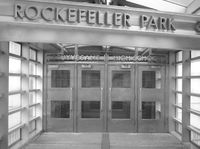
Sports
Stuyvesant fields 32 varsity teams,[49] including a swimming team, as well as golf, bowling, volleyball, soccer, basketball, gymnastics, wrestling, fencing, baseball/softball, handball, tennis, track/cross country,[50] cricket, football,[49] and starting in Spring 2008, lacrosse teams.[49] In addition, Stuyvesant club teams include boys' varsity and junior varsity, and girls' varsity Ultimate teams. The boys' Ultimate team, the Stuyvesant Sticky Fingers, won the UPA New York State Championships and New York City Championships in 2009 and 2010. The girls' Ultimate team, Sticky Fingers, won the UPA Junior National tournament in 1998.[51] The Stuyvesant Cross Country team was Public Schools Athletic League (PSAL) City Champions in 2004, 2005 and 2007, and have been Manhattan Borough Triple Crown Champions since 1999.[52] The Stuyvesant Boys Swimming Team, the Pirates, have been PSAL City Champions consecutively since 2000 and Opens champions since 1995.[53] The girls soccer team, the Mimbas, brought home the City Championship title in 2001, 2004, and 2005, despite a severe lack of practice space and lack of a home field.[54] Stuyvesant is also a powerhouse in fencing with a string of PSAL city championships from 1986 through 1989 and again as recently as 2005 and 2007.[55]
In September 2007 the Stuyvesant football team were granted a home field at Pier 40. Stuyvesant does not, however, have a track, baseball field, or tennis court, although the new building does have a pool.[56]
Unlike most American high schools, most sports teams at Stuyvesant have their own name, such as the Runnin' Rebels (boys' Basketball), Vixens (girls' Volleyball), Lemurs (boys' Gymnastics), Phoenix (girls' Basketball), Renegades (girls' Softball), Felines (girls' Gymnastics), Peglegs (Football and boys' Lacrosse), Hookers (boys' Bowling), Pinheads (girls' Bowling), Huskies (girls' Lacrosse), Penguins (girls' Swimming), Pirates (boys' Swimming), Ballers (boys' Soccer), Mimbas (girls' Soccer), The Furies (girls' Handball), Dragons (boys' Handball), Smokin' Aces (boys' Tennis), Sticky Fingers (boys' and girls' Ultimate), Lobsters (girls' Tennis), Hitmen (Baseball), Untouchables (boys' and girls' Fencing) Flying Dutchmen (Hockey), Tigers (Cricket) and Spartans (Wrestling and Roller Hockey).[49] These names tend to change with time.
ARISTA
The Stuyvesant chapter of ARISTA, the National Honor Society, was founded in 1910. It is an organization dedicated to upholding the four pillars of Character, Scholarship, Leadership, and Service. ARISTA is highly selective. Once selected, ARISTA's members are asked to complete a service requirement of 10 credits per month and to uphold all the pillars for which this organization stands. The ARISTA Executive Council consists of the President, Vice President, Vice President of Events and Services, Vice President of Tutoring, and Vice President of Communications. The ARISTA office is located in the Student Government Room, behind the Senior Bar. ARISTA provides a number of important and useful programs to the community, the school, and the student body.
ARISTA's Tutoring Service includes many programs both inside and outside of school and online. First of these programs is the Peer Tutoring Service, sponsored by the Tutoring Committee and directed by the Vice President of Tutoring. Peer tutoring allows any student who is having trouble in any subject to get help. Also, The Tutoring Committee sponsors numerous Peer Study Workshops throughout the year. New this year is tutoring online.
ARISTA's Events and Service Committee, headed by the Vice President of Events and Services, offer many volunteer opportunities both in school and out of school. Their activities include but are not limited to: monitoring for department offices, ushering for school theater productions, volunteering at parent teacher conferences, working at Soup Kitchens, tutoring at local elementary schools, participating in various walks (such as the MS Walk and the AIDS Walk), and volunteering at Stuyvesant's Open House Events.
Student government
The student body of Stuyvesant is represented by the Stuyvesant Student Union,[2] a group of elected and appointed students who serve the student body in two important areas:[57]
- Improving student life by promoting and managing extracurricular activities (clubs and publications), and by organizing out-of-school activity such as city excursions or fund-raisers.
- Providing a voice to the student body in all discussion of school policy with the administration.
Clubs and publications
Stuyvesant offers clubs, publications, teams and other opportunities under a system similar to that of many colleges. It hosts over 200 clubs ranging from The Thinkers (philosophy) club, to the Photography Club.[58] The sheer number of clubs at the school is due to Stuyvesant's relatively free policy of "student rule". Most clubs are entirely student run, requiring only a Faculty Advisor to maintain their existence. One example of this policy is the Stuyvesant Model UN club, which is one of the largest clubs in the school. The club attends as many as 6 Model UN Conferences each year, held at various Colleges across the Northeast. The club also hosts StuyMUNC, an annual conference organized and run almost entirely by the students. Stuyvesant also has a Junior State of America program (a political debate club). The Stuyvesant Theater Community puts on three student-run productions a year (a fall musical, a winter drama, and a spring comedy) as well as a one-act festival and several smaller studio productions.[59] Key Club International's branch at Stuyvesant was founded in 1990. With over 350 members, it is one of the largest clubs in the school.
The Spectator
The Spectator is Stuyvesant's official school newspaper. It contains eleven sections: news, features, op-ed, arts & entertainment, sports, photography, art, layout, copy, business, and web. Most departments are headed by at least two editors, all of whom encompass the editorial board of the paper. The editorial board meets daily in the Spectator journalism class and is headed by the Editor in Chief and Managing Editor, or two Editors in Chief. At the start of their term, the Executive Editors select three or four editors to be members of the Managing Board, a group that advises the Executive Editors on matters relating to the paper. There are over 250 total staff members who help to produce the bi-weekly publication. At the beginning of the fall and spring terms, there are recruitments, but interested students may join at any time. The Spectator is independent from the school, but it remains a prime news source for students, teachers, and administrators.
The Spectator, founded in 1915, is one of Stuyvesant's oldest publications.[60] It has a long-standing connection with its older namesake, Columbia University's Columbia Daily Spectator, and it has been recognized by the Columbia University Graduate School of Journalism's Columbia Scholastic Press Association on several occasions, most recently in 2009.[61]
The Stuyvesant Standard
Founded in 2001, The Stuyvesant Standard is a non-profit bi-weekly newspaper published by Stuyvesant students. The newspaper is independent and does not receive its funding from the Student Union. It covers school news as well as current events, and contains "interest sections" such as Business, Science, and Technology alongside the standard departments of Opinions, Literacy, Sports, and Arts & Entertainment. The Stuyvesant Standard distributes 2,000 free copies bi-weekly within the Stuyvesant community and throughout the adjoining neighborhoods of TriBeCa and Battery Park City.
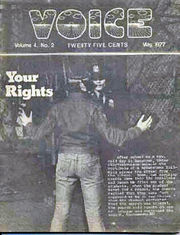
The Voice
The Voice was founded in the 1973–74 academic year as an independent publication only loosely sanctioned by school officials.[60] It had the appearance of a magazine and gained a large readership. The Voice attracted a considerable amount of controversy and a First Amendment lawsuit, after which the administration forced it to go off-campus and to turn commercial in 1975–76.[60]
In the beginning of the 1975–76 academic year, The Voice decided to publish the results of a confidential random survey measuring the "sexual attitudes, preferences, knowledge and experience" of the students.[62] The administration refused to permit The Voice to distribute the questionnaire, and the Board of Education refused to intervene, believing that "irreparable psychological damage" would be occasioned on some of the students receiving it.[62]
The editor-in-chief of The Voice, Jeff Trachtman,[63] brought a First Amendment challenge to this decision in the United States District Court for the Southern District of New York in front of Judge Constance Baker Motley.[62] Judge Motley, relying on the relatively recent Supreme Court precedent Tinker v. Des Moines Independent Community School District (holding that "undifferentiated fear or apprehension of disturbance is not enough to overcome the right to freedom of expression"),[64] ordered the Board of Education to come up with an arrangement permitting the distribution of the survey to the juniors and seniors.
However, Judge Motley's ruling was overturned on appeal to the United States Court of Appeals for the Second Circuit.[65] Judge J. Edward Lumbard, joined by Judge Murray Gurfein and over an impassioned dissent by Judge Walter R. Mansfield, held that the distribution of the questionnaires was properly disallowed by the administration as there was "a substantial basis for defendants' belief that distribution of the questionnaire would result in significant emotional harm to a number of students throughout the Stuyvesant population."[65] The Supreme Court denied certiorari review.[66]
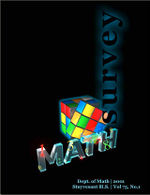
Culture Festival
Stuyvesant's Culture Festival is a student organized event that originated as individual Culture Nights but became a gathering of all cultures in 2007. The Culture Festival is a promotion of Stuyvesant's culturally diverse student body. Though its position as an annual school event is still in question, its increasing popularity and student participation has already made it a new Stuyvesant tradition. Culture Festival performances try to encompass a wide variety of cultures - African, Bengali, Chinese, Korean, Indian, Irish, Japanese, Greek, and many more. Performances include martial arts, comedic skits, instrumentals, singing, and traditional dances such as the Chinese flag dance and Irish Step Dance. There is also an International Buffet in the school cafeteria right before the show.
SUVH's Culture Festival Promotion Video | 2007 | Review on First Culture Festival | 2008's Culture Festival
Other publications
- Antares, the Sci-fi and Fantasy Magazine.
- Caliper, Stuyvesant's biannual literary magazine. Caliper is one of the oldest high school literary publications in the nation, and along with monthly open mic sessions, helps the Stuyvesant literary community flourish in an environment focusing on math and science.
- Indicator, the Stuyvesant yearbook.
- Math Survey, the annual Math Department publication. Many of Stuyvesant's notable mathematicians were first published in Math Survey.
- Inspiration Magazine, an art and literary publication sponsored by the Music and Arts Department.
- The Broken Escalator, a humor publication, styled after The Onion, featuring joke articles about Stuyvesant.
- The Biomed Times, the annual journal of recent biological developments.
- The Edible, the bi-annual food and culture magazine.
- VOLUME, an open short-format publication with articles from 3 - 300 words.
- The Locksmith, the monthly publication of Stuyvesant High School Key Club. [1]
- THE MUSIC, a magazine covering all aspects of the music scene. (THE MUSIC website [2])
Academic teams
Stuyvesant's academic teams include its nationally recognized Speech and Debate team, Quiz Bowl, chess, and math, which regularly compete successfully at major regional (New York State Mathematics League), national (American Regions Mathematics League), and international (International Mathematical Olympiad) tournaments, and whose members fill up a considerable percentage of the New York City Math Team.[67] A FIRST team,[68] StuyPulse, was founded in 2000. Stuyvesant also has a Model United Nations team, a Junior State of America chapter, and a Model Congress team which competes at regional colleges. The Model United Nations team hosts StuyMUNC,[69] an annual conference which takes place at Stuyvesant.
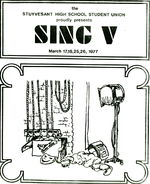
SING!
The annual theater competition known as SING! pits seniors, juniors, and "soph-frosh" (freshmen and sophomores working together) against each other in a race to put on the best performance. Started in 1947 at Midwood High School in Brooklyn, SING! is a tradition at many New York City high schools. At Stuyvesant, SING! started as a small event in 1973 and has grown to a huge school-wide event—in 2005, nearly 1,000 students participated. The entire production is written, directed, produced, and funded by students. Their involvement ranges from being members of the production's casts, choruses, or costume and tech crews to Irish dance, Step, Bollywood, Hip-Hop, Swing, Ballet, Jazz or Latin dance groups. SING! begins in late January to February and culminates in final performances on three nights in March/April. Scoring is done on each night's performances and the winner is determined by the overall total.
Student body
Stuyvesant has contributed to the education of several Nobel laureates, winners of the Fields Medal and the Wolf Prize, and a host of other accomplished alumni. In recent years, it has had the second highest number of National Merit Scholarship semi-finalists, behind Thomas Jefferson High School for Science and Technology, in Alexandria, Virginia,[70]. Over the past nine years (2002-2010), Stuyvesant has produced 103 semi-finalists and 13 finalists on the Intel Science Talent Search, the second most of any secondary school in the United States (after Maryland's Montgomery Blair High School).[71]
For most of the 20th century, the student body at Stuyvesant was heavily Jewish. A significant influx of Asian students began in the 1970s. For the 2008–2009 academic year, the student body was approximately 67% Asian American and 27% Caucasian, 2% Blacks and 3% Hispanics.[72] Stuyvesant possesses a racial breakdown that is far out of proportion to national and local population distributions.[13][21] (See also Demographics of New York City.) Stuyvesant only admits students from New York City, but some who used city addresses to register for the school do travel from Long Island and New Jersey. Many others have long commutes from all five boroughs.
Stuyvesant and 9/11
Stuyvesant is a half-mile (approx. 800 m) or a five-minute walk from the former site of the World Trade Center, which was destroyed on September 11, 2001. The school was evacuated during the attack. Although the smoke cloud coming from the World Trade Center engulfed the building at one point, there was no structural damage to the building, and there were no reports of physical injuries. Less than an hour after the collapse of the second WTC tower, concern over a bomb threat at the school prompted an evacuation of the surrounding area, as reported live by NBC news reporter Pat Dawson on the Today show.[73]
When classes resumed on September 21, 2001, students were moved to Brooklyn Technical High School while the Stuyvesant building served as a base of operations for rescue and recovery workers. This caused serious congestion at Brooklyn Tech, and required the students to attend in two shifts, with the Stuyvesant students attending the evening shift. Normal classes resumed three weeks later on October 9.
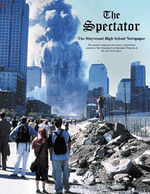
Because Stuyvesant was close to Ground Zero, there were concerns of asbestos exposure. The US EPA indicated at that time that Stuyvesant was safe from asbestos, and conducted a thorough cleaning of the Stuyvesant building, but the Stuyvesant High School Parents' Association has contested the accuracy of the assessment.[74] Some problems, including former teacher Mark Bodenheimer's respiratory problems, have been reported—he accepted a transfer to The Bronx High School of Science after having difficulty continuing his work at Stuyvesant. Other isolated cases include Stuyvesant's 2002 Class President Amit Friedlander, a graduate of the University of Pennsylvania, who received local press coverage in September 2006 after he was diagnosed with cancer.[75] While there have been other cases linked to the same dust cloud that emanated from ground zero, a spot precariously close to Stuyvesant,[76] there is no definitive evidence that such cases have directly affected the Stuyvesant community. Stuyvesant students did spend a full year in the building before the theater and air systems were cleaned, however, and a group of Stuyvesant alumni is currently lobbying for health insurance as a result.[75]
Alumni who were killed in the World Trade Center attack include Daniel D. Bergstein (1980),[77] Alan Wayne Friedlander (1967),[78] Marina R. Gertsberg (1993),[79] Aaron J. Horwitz (1994),[80] David S. Lee (1982),[81] Arnold A. Lim (1990),[82] Gregory D. Richards (1988),[83] Maurita Tam (1997)[84] and Michael Warchola (1968).[85] Richard Ben-Veniste (1960) was on the 9/11 Commission.
On October 2, 2001, the school paper, The Spectator, under Editor in Chief Jeff Orlowski and Faculty Advisor Holly Ojalvo, created a special 24-page full-color 9/11 insert containing student photos, reflections and stories. On November 20, 2001, the magazine was distributed for free in 830,000 copies of The New York Times to the entire New York Greater Metropolitan Area.[86]
In the months after 9/11, Annie Thoms (1993), an English teacher at Stuyvesant and the theater adviser at the time, suggested that the students take accounts of staff and students' reactions during and after 9/11 and turn them into a series of monologues. Thoms then published these monologues as With Their Eyes: September 11—The View from a High School at Ground Zero. Alexander Epstein of The Stuyvesant Standard contributed the section Out of the Blue to the book At Ground Zero: Young Reporters Who Were There Tell Their Stories.
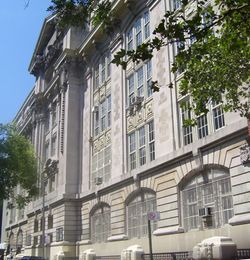
Notable people
Notable scientists among Stuyvesant alumni include mathematician Paul Cohen,[87] String Theorist Brian Greene, celebrity physicist Lisa Randall, and genomic researcher Eric Lander.[88] Other prominent alumni include entertainers such as Charlie's Angels star Lucy Liu,[89] The Shawshank Redemption star Tim Robbins,[90] actor James Cagney,[91] comedian Paul Reiser[92] and NBA basketball player and game fixer/bookmaker Jack Molinas.[93]
In government and politics, the current Attorney General of the United States Eric Holder is a Stuyvesant alumnus (1969),[94] as are Senior Advisor to the President David Axelrod (1972),[95] and former adviser to President Clinton Dick Morris (1964).[96]
Four Nobel laureates are also alumni of Stuyvesant, including:
- Joshua Lederberg (1941) – Nobel Prize in Physiology or Medicine, 1958[97]
- Robert Fogel (1944) – Nobel Memorial Prize in Economic Sciences, 1993[98]
- Roald Hoffmann (1954) – Nobel Prize in Chemistry, 1981[99]
- Richard Axel (1963) – Nobel Prize in Physiology or Medicine, 2004[100]
Author Frank McCourt taught English at Stuyvesant before the publication of his memoirs Angela’s Ashes, ’Tis, and Teacher Man. Teacher Man's third section, titled Coming Alive in Room 205, is all about McCourt's time at Stuyvesant, and mentions a number of students and faculty.[101]
In popular culture
Stuyvesant High School has been featured in television shows, films, books, and other media. The Stuyvesant High School building in Battery Park City was one of the main settings of the film Hackers, standing in for the fictional "Stanton High School".[102] As in the film, the new building has no pool on the roof, despite a long history of seniors selling "rooftop pool passes" to new freshmen in the old building. It does, however, have a pool on the ground floor and a roof deck for its technology classes. The feature-length documentary Frontrunners was made about the Student Union elections at Stuyvesant.[103]
The entrance to the high school is visible in the beginning of the music video for the Beastie Boys song "Ch-Check It Out", as the three rappers walk on the TriBeCa Bridge. Adam Horovitz of the Beastie Boys also wears a red Stuyvesant High School Physical Education leader T-shirt in the video for "(You Gotta) Fight for Your Right (To Party!)". This has sparked a rumor that one or all of the Boys attended Stuyvesant. In fact, only the band's original drummer, Kate Schellenbach, did.[104]
Stuyvesant has been chronicled in popular literature based in New York City. The Jonathan Lethem novels Motherless Brooklyn and Fortress of Solitude are prominent examples of this trend. In Fallen Angels, by Walter Dean Myers, Richie Perry, the main protagonist, attended Stuyvesant High School. In the 1984 novel Warday, some former Stuyvesant students visit New York City after a limited nuclear exchange. In the 2003 novel The Russian Debutante's Handbook by Stuyvesant alumnus Gary Shteyngart, the protagonist Vladimir Girshkin attended a "science high school in Manhattan". The 2006 autobiographical young adult book, The Notebook Girls, highlights the lives of four Stuyvesant students in the form of a journal. In August 2007, Simon & Schuster published 1985 alumnus and Washington Post reporter Alec Klein's book on Stuyvesant entitled A Class Apart: Prodigies, Pressure, and Passion Inside One of America's Best High Schools.[105] In 2006, a controversial article about the different sexual orientations in Stuyvesant and how they represent a national trend appeared in New York magazine.[106]
See also
- Education in New York City
- Health effects arising from the September 11 attacks
- National Consortium for Specialized Secondary Schools of Mathematics, Science and Technology (NCSSSMST)
References
- Notes
- ↑ "2006-2007 New York State Annual School Report Card - Stuyvesant High School" (PDF). New York State Department of Education. 2007. https://www.nystart.gov/publicweb-rc/2007/ca/AOR-2007-310200011475.pdf. Retrieved October 29, 2008.
- ↑ 2.0 2.1 2.2 "High School Directory Entry: Stuyvesant High School". New York City Department of Education. 2007. http://schools.nyc.gov/ChoicesEnrollment/High/Directory/school/?sid=1508. Retrieved March 27, 2008.
- ↑ 3.0 3.1 The nickname "Stuy" is used in many places on the web, including in the name of the school's official website, www.stuy.edu.
- ↑ 4.0 4.1 Jennifer Medina (November 15, 2008). "Two Different Measures". The New York Times. http://www.nytimes.com/imagepages/2008/11/16/nyregion/16cards.graf01.ready.html.
- ↑ "Stuy FAQs". Stuyvesant High School. http://www.stuy.edu/about/faq.php. Retrieved September 17, 2007.
- ↑ "Gold Medal Schools". U.S. News & World Report. November 29, 2007. http://www.usnews.com/articles/education/high-schools/2009/12/09/americas-best-high-schools-gold-medal-list.html?PageNr=2. Retrieved January 11, 2008.
- ↑ (PDF) (Former) Stuyvesant High School. New York City Landmarks Preservation Commission. May 20, 1997. http://home2.nyc.gov/html/lpc/downloads/pdf/reports/stuyvesanths.pdf. Retrieved May 28, 2006.
- ↑ 8.0 8.1 "Stuyvesant High School Timeline by Class Year". The Campaign for Stuyvesant. March 27, 2007. http://www.ourstrongband.org/history/timeline.html. Retrieved June 4, 2006.
- ↑ Cummings, Paul (November 26, 1973). Interview with George Segal. Smithsonian Institution Archives of American Art. http://www.aaa.si.edu/collections/oralhistories/transcripts/segal73.htm. Retrieved June 4, 2006.
- ↑ 10.0 10.1 Blaufarb, Eugene (2005). "History of Stuyvesant High School" (PDF). Stuyvesant High School Parent Handbook. Stuyvesant Parents Association. http://www.stuy-pa.org/files/documents/04-05ParentHandbook.pdf. Retrieved May 28, 2006.
- ↑ "The Cyclotron Committee". The Campaign for Stuyvesant. March 27, 2007. Archived from the original on September 28, 2007. http://web.archive.org/web/20070928022536/http://www.stuyvesant.ourstrongband.org/extracurriculars.htm#cyclotron. Retrieved March 8, 2006.
- ↑ 12.0 12.1 "Stuyvesant 100 Year Timeline". Stuyvesant Centennial Committee. Archived from the original on February 21, 2005. http://web.archive.org/web/20050221111322/http://www.stuy100.org/stuy-timeline.html. Retrieved June 27, 2006.
- ↑ 13.0 13.1 13.2 13.3 Manhattan Superintendency (2003). "2002–2003 Annual Report, Stuyvesant High School" (PDF). New York City Public Schools. Archived from the original on June 28, 2007. http://web.archive.org/web/20070628195704/http://schools.nyc.gov/daa/SchoolReports/03asr/171475.pdf. Retrieved March 8, 2006.
- ↑ 14.0 14.1 14.2 Mac Donald, Heather (Spring 1999). "How Gotham’s Elite High Schools Escaped the Leveller’s Ax". City Journal. http://www.city-journal.org/html/9_2_how_gothams_elite.html. Retrieved May 28, 2006.
- ↑ "NYC Department of Education Specialized High Schools Student Handbook" (PDF). New York City Department of Education. 2005. http://schools.nyc.gov/NR/rdonlyres/D6C3C010-DD6B-4B04-BFFB-3A9C240F27C9/0/SHSAT_Hndbk_0809_toDOE.pdf. Retrieved March 25, 2006.
- ↑ 16.0 16.1 "Specialized Admissions Round". New York City Department of Education. 2007. Archived from the original on August 25, 2007. http://web.archive.org/web/20070825003245/http://schools.nyc.gov/Offices/StudentEnroll/HSAdmissions/hsProcess/Specialadm/special.htm. Retrieved March 8, 2006.
- ↑ David M. Herszenhorn (November 12, 2005). "Admission Test's Scoring Quirk Throws Balance Into Question". The New York Times. http://www.nytimes.com/2005/11/12/nyregion/12exam.html?scp=1&sq=SHSAT&st=nyt. Retrieved April 29, 2008.
- ↑ "Admissions". Stuyvesant High School. http://www.stuy.edu/about/admissions.php. Retrieved April 29, 2008.
- ↑ Corporation Counsel (August 30, 1995). "Appeal of Cary Mark Goodman, on behalf of his son, Mosah Fernandez Goodman, from action of the Board of Education of the City School District of the City of New York regarding a specialized high school test". New York City Department of Education. http://www.counsel.nysed.gov/Decisions/volume35/d13477.htm. Retrieved March 8, 2006.
- ↑ 20.0 20.1 Secret Apartheid II: Race, Regents, and Resources. Association of Community Organizations for Reform Now. 1997. http://www.acorn.org/index.php?id=540. Retrieved May 6, 2006.
- ↑ 21.0 21.1 Stern, Sol (2003). "Façade of Excellence". Hoover Institution. http://www.hoover.org/publications/ednext/3347501.html. Retrieved March 8, 2006.
- ↑ Hart, Jeffrey (May 28, 1997). Destroying Excellence. Archived from the original on October 30, 2004. http://web.archive.org/web/20041030110521/http://www.dartreview.com/archives/1997/05/28/destroying_excellence.php. Retrieved June 27, 2006.
- ↑ Bumiller, Elisabeth (April 2, 1998). "PUTTING DREAMS TO THE TEST: A special report; Elite High School Is a Grueling Exam Away". The New York Times. http://www.nytimes.com/1998/04/02/nyregion/putting-dreams-test-special-report-elite-high-school-grueling-exam-away.html. Retrieved May 2, 2009.
- ↑ "Specialized High Schools Institute". New York City Department of Education. March 11, 2009. http://schools.nyc.gov/ChoicesEnrollment/Middle/SHSI/default.htm. Retrieved May 2, 2009.
- ↑ Gootman, Elissa (August 18, 2006). "In Elite N.Y. Schools, a Dip in Blacks and Hispanics - New York Times". The New York Times. http://www.nytimes.com/2006/08/18/education/18schools.html. Retrieved May 2, 2009.
- ↑ "Graduation Requirements" (PDF). Stuyvesant High School Parent Handbook. Stuyvesant Parents Association. 2004. http://www.stuy-pa.org/files/documents/04-05ParentHandbook.pdf. Retrieved May 28, 2006.
- ↑ "Graduation Requirements". Stuyvesant High School. http://register.stuy.edu/program_office/grad_reqs.html. Retrieved May 28, 2006.
- ↑ 28.0 28.1 "Online Course Guide". Stuyvesant High School. http://register.stuy.edu/program_office/course_descriptions.html. Retrieved May 28, 2006.
- ↑ "Stuyvesant H.S. 100 Year Anniversary". Stuyvesant Centennial Committee. Archived from the original on March 5, 2005. http://web.archive.org/web/20050305222753/http://www.stuy100.org/about.html. Retrieved June 27, 2006.
- ↑ Levin (September 7, 2005). "Stuyvesant Muslim students now able to study Arabic". Village Voice. http://www.thevillager.com/villager_123/stuyvensantmuslimstudents.html. Retrieved April 29, 2008.
- ↑ Kim, Jin-ji (October 18, 2004). "Stuyvesant Students Get a Taste of College After School". The Spectator. Archived from the original on February 23, 2005. http://web.archive.org/web/20050223090251/http://spectator.stuy.edu/display.cgi?id=1361. Retrieved June 27, 2006.
- ↑ "Staff Editorial". The Spectator. Archived from the original on February 23, 2005. http://web.archive.org/web/20050223084654/http://spectator.stuy.edu/display.cgi?id=1360. Retrieved June 27, 2006.
- ↑ Saulny, Susan (January 26, 2006). "New York Tops Advanced Placement Tests". The New York Times. http://www.nytimes.com/2005/01/26/education/26advanced.html. Retrieved March 8, 2006.
- ↑ Morgan, Richard (August 26, 2002). "Elite Private High Schools Serve as 'Feeder System' Into Top Colleges, Magazine Reports". The Chronicle of Higher Education. Archived from the original on August 19, 2009. http://www.utsystem.edu/News/Clips/DailyClips/2002/0825-0831/HigherEd-CHE-ElitePrivateHighSchools-082602.pdf.
- ↑ Gamerman, Ellen (December 28, 2007). "How the Schools Stack Up". The Wall Street Journal. http://online.wsj.com/public/resources/documents/info-COLLEGE0711-sort.html. Retrieved January 1, 2008.
- ↑ Kantrowitz, Barbara; Pat Wingert (May 8, 2006). "What Makes a High School Great?". Newsweek. http://www.newsweek.com/id/34509. Retrieved April 12, 2008.
- ↑ Mathews, Jay (May 8, 2005). "America's Best High Schools FAQ". Newsweek. http://www.newsweek.com/id/39380. Retrieved August 2, 2006.
- ↑ Melago, Carrie (March 11, 2007). "U.S. News & World Report gives city schools high marks in new list". Daily News. http://www.nydailynews.com/ny_local/education/2007/11/30/2007-11-30_us_news__world_report_gives_city_schools.html. Retrieved March 31, 2008.
- ↑ Muschamp, Herbert (June 6, 1993). "Architecture View; On the Hudson, Launching Minds Instead of Ships". The New York Times. http://www.nytimes.com/1993/06/06/arts/architecture-view-on-the-hudson-launching-minds-instead-of-ships.html. Retrieved May 28, 2006.
- ↑ "Stuyvesant promotional video" (video (WMV)). The Campaign for Stuyvesant. Archived from the original on February 28, 2008. http://web.archive.org/web/20080228195504/http://www.ourstrongband.org/Videos/CampaignForStuyvesant_Broadband.wmv. Retrieved March 8, 2006.
- ↑ "Current List of Accessible Schools" (PDF). New York City Department of Education. June 2007. pp. 23. http://schools.nyc.gov/NR/rdonlyres/41ACD8D4-DDD2-4F1A-AEF0-AF3A9D132EBB/0/ListofAccessibleSchools2007.pdf. Retrieved March 28, 2008.
- ↑ "Celebration (Richard Rothenberg Memorial), 1999". CultureNOW. http://www.culturenow.org/ManhattanArtNOW/index.php?page=display_entry&work_num=1652. Retrieved March 17, 2009.
- ↑ "Welcome, Institute for Collaborative Education, M407". New York City Department of Education. August 27, 2008. http://schools.nyc.gov/SchoolPortals/02/M407/default.htm. Retrieved August 27, 2008.
- ↑ "Welcome, P.S. M226, M226". New York City Department of Education. August 27, 2008. http://schools.nyc.gov/SchoolPortals/02/M226/default.htm. Retrieved August 27, 2008.
- ↑ "Welcome, High School for Health Professions and Human Services, M420". New York City Department of Education. August 27, 2008. http://schools.nyc.gov/SchoolPortals/02/M420/default.htm. Retrieved August 27, 2008.
- ↑ "Directions and parking info". American Sign Language and English Lower School (PS 347). October 30, 2006. http://www.47lowerschool.org/site_res_view_template.aspx?id=9cb3255c-8fcf-4499-a535-266d28c513a2. Retrieved August 27, 2008.
- ↑ "Stuy³: A site about Mnemonics". Stuyvesant High School. http://www.stuy.edu/stuycube/. Retrieved January 26, 2008.
- ↑ "Kristin Jones - Andrew Ginzel". Kristin Jones and Andrew Ginzel. April 20, 2007. http://www.jonesginzel.com/PROJECTS/ALL/mnemonics/mnemonics.html. Retrieved February 14, 2008.
- ↑ 49.0 49.1 49.2 49.3 "PSAL profile: Stuyvesant". Public Schools Athletic League. http://www.psal.org/psalsports/school/psal_schoolprofile.asp?cschool=02519. Retrieved September 17, 2007.
- ↑ "PSAL Cross Country City Championship Results". Public Schools Athetic League. November 10, 2007. http://www.psal.org/psalsports/news/psal_stories.asp?ID=15388. Retrieved January 1, 2008.
- ↑ Leonardo, Tony (1998). "1998 High School (Juniors) Nationals". Archived from the original on May 17, 2006. http://web.archive.org/web/20060517164423/http://www.rivative.net/ultimate/1996_1998/98nationals_hs.html. Retrieved January 26, 2008.
- ↑ Graber, Michael (November 30, 2007). "Curtis Girls and Stuyvesant Boys Shine at PSAL XC Championships". Public Schools Athetic League. http://www.psal.org/psalsports/articles/psal_stories.aspx?storyid=15392. Retrieved January 26, 2008.
- ↑ "PSAL Boys Swimming Champions". Public Schools Athetic League. http://www.psal.org/psalsports/articles/psal_stories.aspx?storyid=14718. Retrieved January 26, 2008.
- ↑ "PSAL Girls Soccer Champions". Public Schools Athetic League. http://www.psal.org/psalsports/articles/psal_stories.aspx?storyid=14690. Retrieved January 26, 2008.
- ↑ "PSAL Boys Fencing Champions". Public Schools Athetic League. http://www.psal.org/psalsports/articles/psal_stories.aspx?storyid=14573. Retrieved January 26, 2008.
- ↑ "Stuyvesant Athletics". Stuyvesant High School. http://physed.stuy.edu/sportsteam.html. Retrieved March 8, 2006.
- ↑ "Constitution of the Student Union". Stuyvesant High School Student Union. Archived from the original on February 5, 2008. http://web.archive.org/web/20080205210441/http://www.stuysu.org/www/getpage.php?cat=community&name=Constitution. Retrieved March 27, 2008.
- ↑ "Clubs and Pubs". Stuyvesant High School Student Union. Archived from the original on February 9, 2008. http://web.archive.org/web/20080209145929/http://www.stuysu.org/cp. Retrieved May 28, 2006.
- ↑ "Stuyvesant Theater Community". Stuyvesant High School. Archived from the original on May 16, 2007. http://web.archive.org/web/20070516042316/http://www.stuytheater.org/. Retrieved March 8, 2006.
- ↑ 60.0 60.1 60.2 "The Spectator". Stuyvesant High School Extra-curricula's. The Campaign for Stuyvesant. Archived from the original on September 28, 2007. http://web.archive.org/web/20070928022536/http://www.stuyvesant.ourstrongband.org/extracurriculars.htm#Spectator. Retrieved March 18, 2007.
- ↑ "Awards to People". Columbia Scholastic Press Association. http://www.columbia.edu/cu/cspa/docs/awards-to-people/sullivan/recipients/index.html. Retrieved May 28, 2006.
- ↑ 62.0 62.1 62.2 Trachtman v. Anker, 426 F.Supp. 198 .
- ↑ Trachtman eventually went to law school, clerked for Judge Motley, and became a partner at Kramer Levin Naftalis & Frankel. He cited his Stuyvesant experience as the motivation for becoming an attorney. Adcock, Thomas (March 16, 2007). "Conversation with Jeffrey S. Trachtman". New York Lawyer. Archived from the original on January 2, 2008. http://web.archive.org/web/20080102054036/http://www.nylawyer.com/display.php/file=/probono/news/07/031607a. Retrieved March 18, 2007.
- ↑ 393 U.S. 503, 508 (1969)
- ↑ 65.0 65.1 Trachtman v. Anker, 563 F.2d 512 .
- ↑ Trachtman v. Anker, 435 U.S. 925 .
- ↑ "New York City ARML Teams 2008". New York City Math Team. http://www.nycmathteam.com/wp-content/uploads/2008/05/ARML%20teams%202008.doc. Retrieved October 1, 2008.
- ↑ "Stuyvesant Robotics 694". Stuyvesant High School FIRST Team. http://www.stuypulse.com. Retrieved March 4, 2009.
- ↑ "StuyMUNC". Stuyvesant High School Model UN Team. http://stuymun.googlepages.com/home.html. Retrieved April 2, 2008.
- ↑ http://www.getlisty.com/preview/2009-top-high-schools-by-national-merit-semi-finalists
- ↑ Huler, Scott (April 15, 1991). "Nurturing Science's Young Elite: Westinghouse Talent Search". The Scientist. http://www.math.uncc.edu/~hbreiter/doc9.htm. Retrieved July 9, 2006.
- ↑ "Stuyvesant High School". New York City Department of Education. 2008. http://schools.nyc.gov/SchoolPortals/02/M475/AboutUs/Statistics/register.htm. Retrieved November 12, 2008.
- ↑ Dawson, Pat (September 11, 2001). "Pat Dawson on 9/11". Today show (NBC). http://www.youtube.com/watch?v=UalzbIX5_Ag. Retrieved December 16, 2009.
- ↑ Newman, Dave (September 15, 2003). "Parents' Association briefing about EPA report" (MS-Word). Stuvesant High School Parents Association. http://www.stuypa.org/Environment/OIG%20Summary%2009-15-03.doc. Retrieved March 8, 2006.
- ↑ 75.0 75.1 Krangle, Eric (October 2, 2006). "Stuyvesant Grads Say They Returned Too Soon After 9/11". The New York Sun. http://www.nysun.com/new-york/stuyvesant-grads-say-they-returned-too-soon-after/40726/. Retrieved October 4, 2006.
- ↑ Westfeldt, Amy (May 24, 2007). "New York Links Death to 9/11 Dust". Associated Press. Archived from the original on May 28, 2007. http://web.archive.org/web/20070528170511/http://news.aol.com/topnews/articles/_a/new-york-links-death-to-911-dust/20070524102409990001?ncid=NWS00010000000001. Retrieved May 24, 2007.
- ↑ "Daniel D. Bergstein". September 11, 2001 Victims. Archived from the original on September 30, 2007. http://web.archive.org/web/20070930181229/http://www.september11victims.com/september11victims/VictimInfo.asp?ID=519. Retrieved March 8, 2006.
- ↑ "Alan Wayne Friedlander". September 11, 2001 Victims. Archived from the original on September 30, 2007. http://web.archive.org/web/20070930181320/http://www.september11victims.com/september11victims/VictimInfo.asp?ID=1113. Retrieved March 8, 2006.
- ↑ "Marina R. Gertsberg". September 11, 2001 Victims. Archived from the original on February 8, 2008. http://web.archive.org/web/20080208194259/http://www.september11victims.com/september11victims/VictimInfo.asp?ID=1173. Retrieved March 8, 2006.
- ↑ "Aaron J. Horwitz". September 11, 2001 Victims. Archived from the original on September 30, 2007. http://web.archive.org/web/20070930181206/http://www.september11victims.com/september11victims/VictimInfo.asp?ID=1383. Retrieved March 8, 2006.
- ↑ "David S. Lee". September 11, 2001 Victims. Archived from the original on September 30, 2007. http://web.archive.org/web/20070930181451/http://www.september11victims.com/september11victims/VictimInfo.asp?ID=3515. Retrieved March 8, 2006.
- ↑ "Arnold A. Lim". September 11, 2001 Victims. Archived from the original on September 30, 2007. http://web.archive.org/web/20070930181250/http://www.september11victims.com/september11victims/VictimInfo.asp?ID=1650. Retrieved March 8, 2006.
- ↑ "Gregory D. Richards". September 11, 2001 Victims. Archived from the original on September 30, 2007. http://web.archive.org/web/20070930181432/http://www.september11victims.com/september11victims/VictimInfo.asp?ID=2275. Retrieved March 8, 2006.
- ↑ "Maurita Tam". September 11, 2001 Victims. Archived from the original on November 17, 2007. http://web.archive.org/web/20071117060900/http://www.september11victims.com/september11victims/VictimInfo.asp?ID=2602. Retrieved March 8, 2006.
- ↑ "Michael Warchola". September 11, 2001 Victims. Archived from the original on October 18, 2007. http://web.archive.org/web/20071018210917/http://september11victims.com/september11victims/VictimInfo.asp?ID=2747. Retrieved March 8, 2006.
- ↑ "September 11th 2001 Special Edition" (PDF). The Spectator (The New York Times). Fall 2001. Archived from the original on June 8, 2009. http://stuyspectator.com/pdf/wtc.pdf. Retrieved September 16, 2007.
- ↑ Levy, Dawn (March 28, 2007). "Paul Cohen, winner of world’s top mathematics prize, dies at 72". Stanford Report. http://news-service.stanford.edu/news/2007/april4/cohen-040407.html. Retrieved October 31, 2007.
- ↑ Hopkin, Karen. "Eric S. Lander, Ph.D.". http://www.hhmi.org/biointeractive/genomics/lander.html. Retrieved October 31, 2007.
- ↑ Ogunnaike, Lola (October 13, 2003). "The Perks and Pitfalls Of a Ruthless-Killer Role; Lucy Liu Boosts the Body Count in New Film". The New York Times. http://www.nytimes.com/2003/10/13/movies/perks-pitfalls-ruthless-killer-role-lucy-liu-boosts-body-count-new-film.html. Retrieved November 1, 2007.
- ↑ "Inside the Actors Studio - Guests - Tim Robbins". Bravo. December 5, 1999. Archived from the original on August 4, 2007. http://web.archive.org/web/20070804064345/http://www.bravotv.com/Inside_the_Actors_Studio/guest/Tim_Robbins. Retrieved November 1, 2007.
- ↑ Flint, Peter (March 31, 1986). "James Cagney Is Dead at 86; Master of Pugnacious Grace". The New York Times. http://www.nytimes.com/learning/general/onthisday/bday/0717.html. Retrieved November 1, 2007.
- ↑ Lyman, Rick (September 5, 1997). "Be It Ever So Urban, It's Green". The New York Times. http://www.nytimes.com/1997/09/05/arts/be-it-ever-so-urban-it-s-green.html. Retrieved June 27, 2009.
- ↑ Konigsberg, Eric (March 3, 2002). "Double Dribbling". The New York Times. http://www.nytimes.com/2002/03/03/books/double-dribbling.html. Retrieved November 12, 2008.
- ↑ Tucker-Hamilton, Racine; Hickey, Matthew (December 17, 2004). "Interview with Eric H. Holder, Jr.". Oral history project (The History Makers). http://www.thehistorymakers.com/programs/dvl/files/Holder_Ericf.html. Retrieved November 18, 2008.
- ↑ Kaiser, Robert G. (May 2, 2008). "The Player at Bat - David Axelrod, the Man With Obama's Game Plan, Is Also the Candidate's No. 1 Fan". The Washington Post. http://www.washingtonpost.com/wp-dyn/content/article/2008/05/01/AR2008050103509.html?nav=hcmodule. Retrieved May 6, 2008.
- ↑ Mitchell, Alison (October 20, 1995). "President's Guru Goes Public; Back Home, Dick Morris Tells Tales From the Clubhouse". The New York Times. http://query.nytimes.com/gst/fullpage.html?res=990CE7D61538F933A15753C1A963958260. Retrieved November 2, 2007.
- ↑ "Joshua Lederberg - The Nobel Prize in Physiology or Medicine 1958 - Biography". 1958. http://nobelprize.org/nobel_prizes/medicine/laureates/1958/lederberg-bio.html. Retrieved October 31, 2007.
- ↑ Gibson, Lydialyle (May/June 2007). "The human equation". The University of Chicago Magazine (University of Chicago) 99 (5). http://magazine.uchicago.edu/0726/features/human.shtml. Retrieved October 31, 2007.
- ↑ "Roald Hoffmann's land between chemistry, poetry and philosophy". http://www.roaldhoffmann.com/pn/modules.php?op=modload&name=Sections&file=index&req=viewarticle&artid=11&page=1. Retrieved October 31, 2007.
- ↑ Eisner, Robin (Winter 2005). "Richard Axel: One of the Nobility in Science". P&S (Columbia University). http://www.cumc.columbia.edu/news/journal/journal-o/winter-2005/nobility.html. Retrieved October 31, 2007.
- ↑ Ben Yagoda (December 4, 2005). "The Stuyvesant Test". The New York Times. http://www.nytimes.com/2005/12/04/books/review/04yagoda.html?_r=1&ex=1136350800&en=46ebc49f10156457&ei=5070&oref=slogin. Retrieved April 28, 2008.
- ↑ "News Archive - "Movie Set"". Stuyvesant High School Alumni Association. http://www.shsaa.org/index.php?option=com_content&task=view&id=118&Itemid=32. Retrieved April 28, 2008.
- ↑ "FrontRunners The Film :: Is America Ready for a Teenage President?". Suh Films. http://www.suhfilms.com. Retrieved September 1, 2007.
- ↑ Smith, Alex (September 24, 2001). "Q&A With Mike D. of the Beastie Boys". Time. http://www.time.com/time/musicgoesglobal/na/mmiked.html. Retrieved April 25, 2008.
- ↑ Jack Mantey (August 5, 2007). "At the Head of the Class". U.S. News & World Report. Archived from the original on October 24, 2007. http://web.archive.org/web/20071024033335/http://www.usnews.com/usnews/news/articles/070805/13qa_print.htm/. Retrieved August 7, 2007.
- ↑ Morris, Alex (January 30, 2006). "The Cuddle Puddle of Stuyvesant High School". New York. http://nymag.com/news/features/15589/. Retrieved March 29, 2006.
- Further reading
- Articles
- Glickman, Emily (2002). "Abacus Guide to Stuyvesant High School". Abacus Guide Educational Consulting. Archived from the original on April 7, 2005. http://web.archive.org/web/20050407041310/http://www.abacusguide.com/stuyvesant_high_school.htm. Retrieved March 9, 2006.
- Gonzalez, Juan (September 10, 2002). "Fallout: The Hidden Environmental Consequences of 9/11". In These Times. http://www.alternet.org/911oneyearlater/14073. Retrieved March 9, 2006.
- "Monitoring Data: Stuyvesant High School". United States Environmental Protection Agency. Archived from the original on January 25, 2004. http://web.archive.org/web/20040125082038/http://oaspub.epa.gov/nyr/bulk_dust_monitoring?p_addr_id=0360610308. Retrieved March 9, 2006.
- "Monitoring Data: Stuyvesant High (North Side)". United States Environmental Protection Agency. Archived from the original on May 29, 2007. http://web.archive.org/web/20070529025841/http://oaspub.epa.gov/nyr/asbestos_monitoring?p_addr_id=0360610406. Retrieved March 9, 2006.
- Books
- Thoms, Annie (2002). With Their Eyes: September 11—The View from a High School at Ground Zero. HarperCollins. ISBN 0-06-051718-2.
- Epstein, Alexander (September 2002). Sam Erman, Chris Bull. ed. At Ground Zero: Young Reporters Who Were There Tell Their Stories. Thunder's Mouth Press. ISBN 1-56025-427-0.
- Klein, Alec (August 2007). A Class Apart: Prodigies, Pressure, and Passion Inside One of America's Best High Schools. Simon & Schuster. ISBN 978-0743299442.
- McCourt, Frank (November 2005). Teacher Man. Scribner. ISBN 978-0743243773.
- Susann E., Meyer (2005). Stuyvesant High School: The First 100 Years. The Campaign for Stuyvesant.
External links
- Stuyvesant HS official website
- Stuyvesant High School's Official Newspaper—The Spectator
- Conan O'Brien's 2006 graduation speech Part One Part Two
- The "1948 Math Survey". Archived from the original on September 28, 2007. http://web.archive.org/web/20070928013847/http://65.104.11.121/Srv1948F/index.html.
- The Campaign for Stuyvesant Endowment Fund
|
||||||||||||||||||||